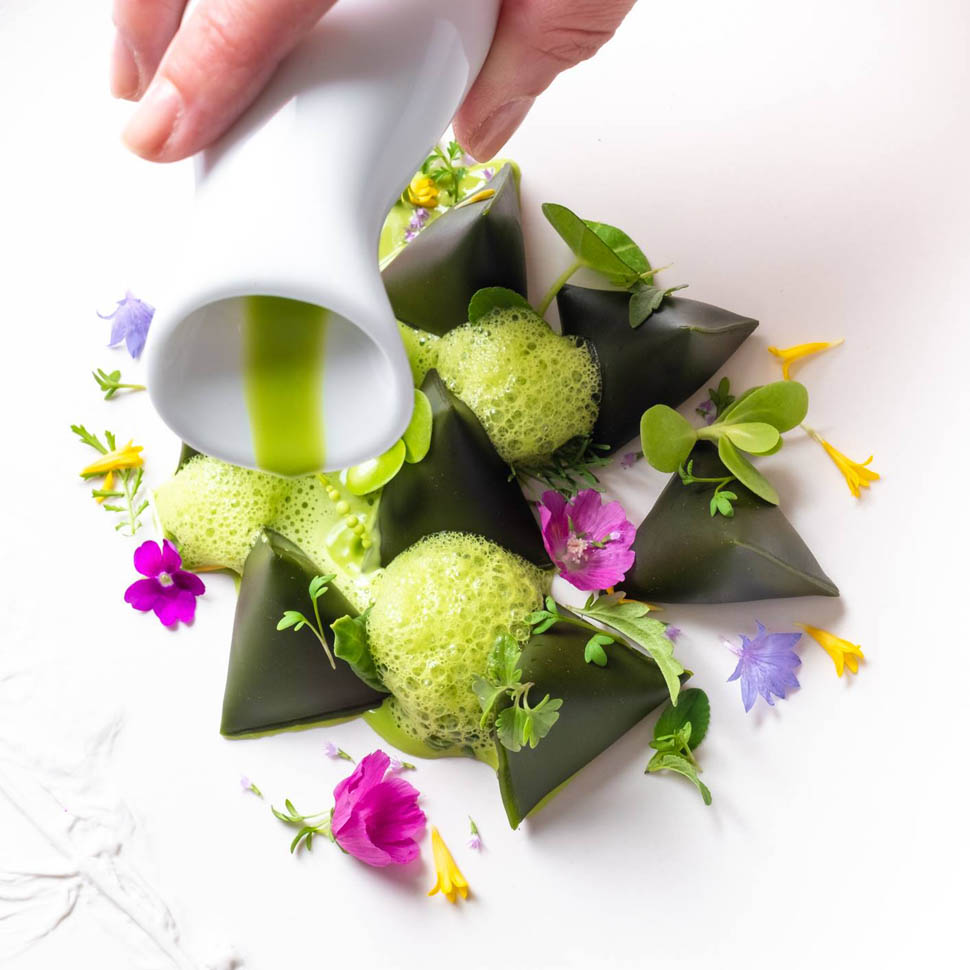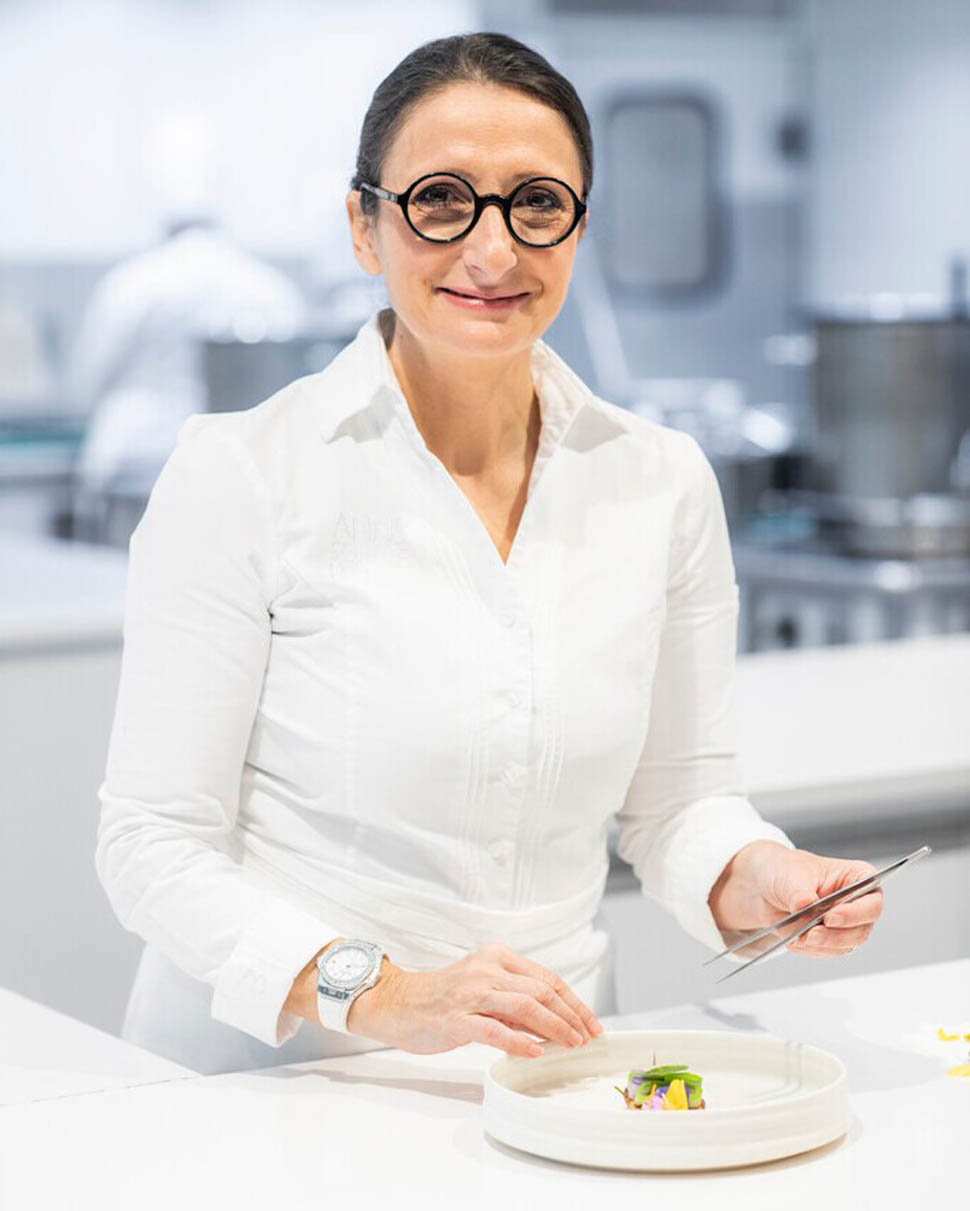The best ravioli recipe? It’s from a French chef who, with 10 Michelin stars, is the most awarded in history: Anne-Sophie Pic. Find out here how to make her remarkable “green pasta.”
Dish photo by Alexandre Bienfait
The story
La dame de Pic, also known as Anne-Sophie, is the queen of Michelin stars: she was the first woman in France to achieve a triple star after Eugénie Brazier’s long absence following her retirement in 1968, and she still holds the world record for women with a total of 10 Michelin stars. Daughter and granddaughter of chefs, she grew up in a shaky French culinary institution, yet she’s entirely self-taught. Over the years, she has become a proponent of a highly sensitive and seductive cuisine with impeccable aesthetics.

One of her signature dishes, the berlingots, showcases her unique interpretation of filled pasta, presented with ever-changing flavors and combinations. The consistent feature is the tetrahedral shape, inspired by the typical Carpentras candies from Provence, said to have been created by Pope Clement V in the 14th century. These tetrahedrons are also distinguished by their white pulled-sugar stripes on vibrant colors, blown like Murano glass by skilled confectioners.

The dish and the pairing
Semantic play and word games are a legacy of nouvelle cuisine, which often renamed dishes by mixing sweet and savory, blending branches and statuses of food to subvert expectations. Anne-Sophie Pic embraces this, but her focus is entirely on the dish itself. "The berlingot is a good representation of my current cuisine," she says. "I call it ‘green fondant’; my dishes often have names that sound like haikus dedicated to them. It all started as a challenge: I wanted to create cheese-based dumplings with a slightly different shape from those I knew or that existed at the time. I've always been fascinated by berlingots, the typical candies from Carpentras. And that's how the dish was born, almost intuitively."

Here, the similarity with the geometrically shaped candies extends to the melting consistency due to the ultra-thin pasta and the magic of the filling. This spring version sees the richness of cheese blended with the sharpness of aromatic vegetables and the herbal notes of matcha tea, resulting in a symphony of delicate flavors. The pairing is a Chablis Grand Cru Les Preuses from Vincent Dauvissat, chosen for its minerality and floral and citrus notes.
MELTING BERLINGOT WITH GOAT CHEESE AND SPRING WATERCRESS

Ingredients for 4 people
For the pasta
- 1 kg of flour
- 600 g of egg yolks
- 50 ml of olive oil
- A splash of white vinegar
- 30 g of matcha tea
- Fine salt
Knead the flour with the egg yolks, olive oil, a splash of vinegar (to prevent clumps), salt, and matcha tea, adjusting the quantity as desired. Vacuum-seal the dough and refrigerate for at least an hour. Roll out to a thickness of 1 mm, fold, and roll out again. Set aside.
For the filling
- 1 kg of Banon goat cheese without the rind
- 1 kg of mascarpone
- 1 kg of sheep's milk ricotta (brousse)
- Fine salt
Place the mascarpone on a piece of damp paper towel and smoke it for 20 minutes. Blend the goat cheese, ricotta, and smoked mascarpone in a blender. Heat the mixture in a saucepan to dissolve the lumps. Strain through a chinois sieve and cool rapidly. Transfer to a pastry bag and refrigerate. Form small dollops of filling on the rolled pasta sheets, spacing them 4 cm apart, then shape into tetrahedrons.
For the matcha tea butter
- 250 g of demi-sel butter
- 3 g of matcha tea
Cut the butter into small pieces and soften it in a warm place, then work it into a creamy consistency before incorporating the matcha tea. Set aside.
For the watercress and matcha tea sauce
- 100 g of watercress juice
- 60 g of matcha tea butter
- A splash of bergamot juice
- 5 g of ginger
- Fine salt
Emulsify the watercress juice with the matcha tea butter, adjust the acidity with the bergamot juice, and add ginger if needed. Season to taste. When serving, distribute the sauce on the plates.
For the finishing touches
- Swiss chard leaves
- Komatsuna leaves
- Purslane leaves
- Radish flowers
- Chickweed leaves
- Vegetable broth
- White balsamic vinaigrette
- Olive oil
- Butter
- Fine salt
Separate the Swiss chard leaves and keep them in a cool place. Clean and separate the komatsuna leaves, then sauté them in a mixture of oil and butter. Add some vegetable broth, cover, and let it simmer. Stop the cooking before they become too soft. Cut into 3 cm x 4 mm sticks and set aside.
Cook the berlingots in boiling salted water for about 2 minutes, then toss them with some butter. Plate them along with the Swiss chard leaves. Finish the dish with separately dressed herbs and flowers.












